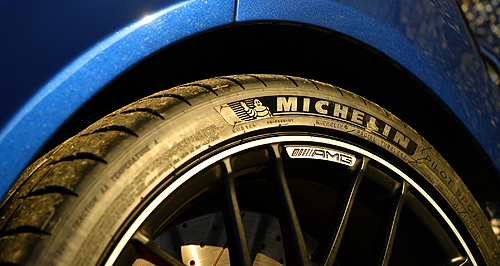Make / Model Search
News - Michelin‘Connected’ tyre technology years away: MichelinNot connected: A connected tyre is still years off, a Michelin exec has confirmed at the launch of the Pilot Sport 4S launch. Tyre that talks to engine management in Michelin mid-term plan8 May 2017 By DANIEL DeGASPERI in ABU DHABI CHANGES in tyre compound technology have been cited at the next big advancement in rubber, according to a key Michelin executive who also believes that that the breakthrough ‘connected’ tyre is still years away from production. Speaking with GoAuto at the international media launch of the Michelin Pilot Sport 4S in Abu Dhabi, Michelin engineering support and operational marketing manager Charles Donahoe revealed that tread design changes were running a distant second to that of tyre architecture in the brand’s research laboratories. “Tread design between Pilot Super Sport and Pilot Sport 4S is visual and it has a big influence, but where we’ve really been able to make the biggest improvements is in the compound changes and in those functional aspects,” Mr Donahoe explained. “Under cornering force and heavy load, the contact patch changes shape and … while tread design and tread pattern has an influence, the biggest influence is the architecture, so how the tyre functions when it’s pushed really hard. “We (are starting) to understand more how we can get these elastomers to deliver different performance characteristics and work within wide temperature ranges. This really is the big breakthrough at the moment, in the understanding of those elastomers and how to mix them to really exploit (performance).” Mr Donahoe further revealed that “the compounds are completely different” in the new Pilot Sport 4S compared with its predecessor, the seven-year-old Pilot Super Sport. Asked whether compound technology still had a lot further to go in terms of development compared with the advancement of tread design, Mr Donahoe replied: “Yes.” The next major development, however, was seen as the ‘connected’ tyre that communicates wear and other factors with a vehicle’s engine management and electronic stability control (ESC) to fine-tune the operation of such systems. Michelin rival Goodyear has shown this as a concept, but Mr Donahoe warned that the technology was still years away from seeing production. “It’s interesting to see one specific competitor was talking about something at the Geneva motor show as if it was ready to go, but when you probe a bit more, there’s really not the technology behind it yet to deliver it to the market,” Mr Donahoe opined. “The end goal is to have a connected tyre. We’ve all got our smartphones (and) smart watches that record hours of sleep, heart rate, health, fitness, hours spent exercising. We’d love to have a connected tyre, where you monitor temperature, treadlife, age of tyre, all of these elements that would ultimately contribute to safer driving. “We’re playing with technologies similar to our competitors (but) we’ve had a few attempts (and) we’re not convinced it’s yet at the level.” The technology was a “medium-term” development, the Michelin executive insisted, although he added that “the technology is coming along pretty quickly”. “It’s all algorithms in the chip that basically look at pressure growth and try to calculate temperature and pressure in the tyre,” he said. “If you put all these elements into a tyre, all these elements into the car, say that they car arrives at an obstacle in the road, and it causes a car accident, there's really not a lot that you could have put in terms of technology into the vehicle that could have avoided that accident. “But when you start really talking about a connected motorway or motoring world, you can warn the people behind you, so when you’re connected to a larger grid, it doesn't necessarily protect the person who has that technology, but it alerts other people that there may be a safety risk. “Far ahead, we’re taking the driver out of the car too (with autonomous vehicles). We’re talking about a world where there’s maybe no need for traffic lights, because if everything is connected then it’s all in sync. I think ultimately this larger grid is what tyres will be connected to. You’ll have a tyre that can talk to the car, a car that can talk to the larger network.” According to Mr Donahoe the last major development in tyres, the controversial run-flat design, would not pass anytime soon. Despite admitting that the “initial drawbacks are still there (but) they’ve just been reduced,” some car brands were keeping up the pressure on Michelin for progressing the technology that allows buyers to drive briefly on a punctured tyre. “The inherent disadvantage with having a run-flat is a clear impact on rolling resistance,” he said. “You’re putting more material in the tyre, creating more rolling resistance, increasing fuel consumption, and the big trade-off is also in ride comfort. Where we’re at with our second generation is we’re lighter, we’ve improved the rolling resistance, the tyres are more comfortable (and) better accepted by customers.” But the technology would not graduate into the realms of Michelin’s sportscar tyres such as the Pilot Sport 4S, because of such drawbacks. Luxury-based tyres, however, would continue with a development of the run-flat design. “It’s something that’s here to stay (and) we need to accept that,” he added. “BMW and Mercedes are the key drivers in pushing that run-flat, but not for a sports application. If you were to put (it in) a consumer segment … the people who buy a luxury car aren’t going to get their hands dirty.”  Read more |
Click to shareMichelin articlesMotor industry news |












Facebook Twitter Instagram